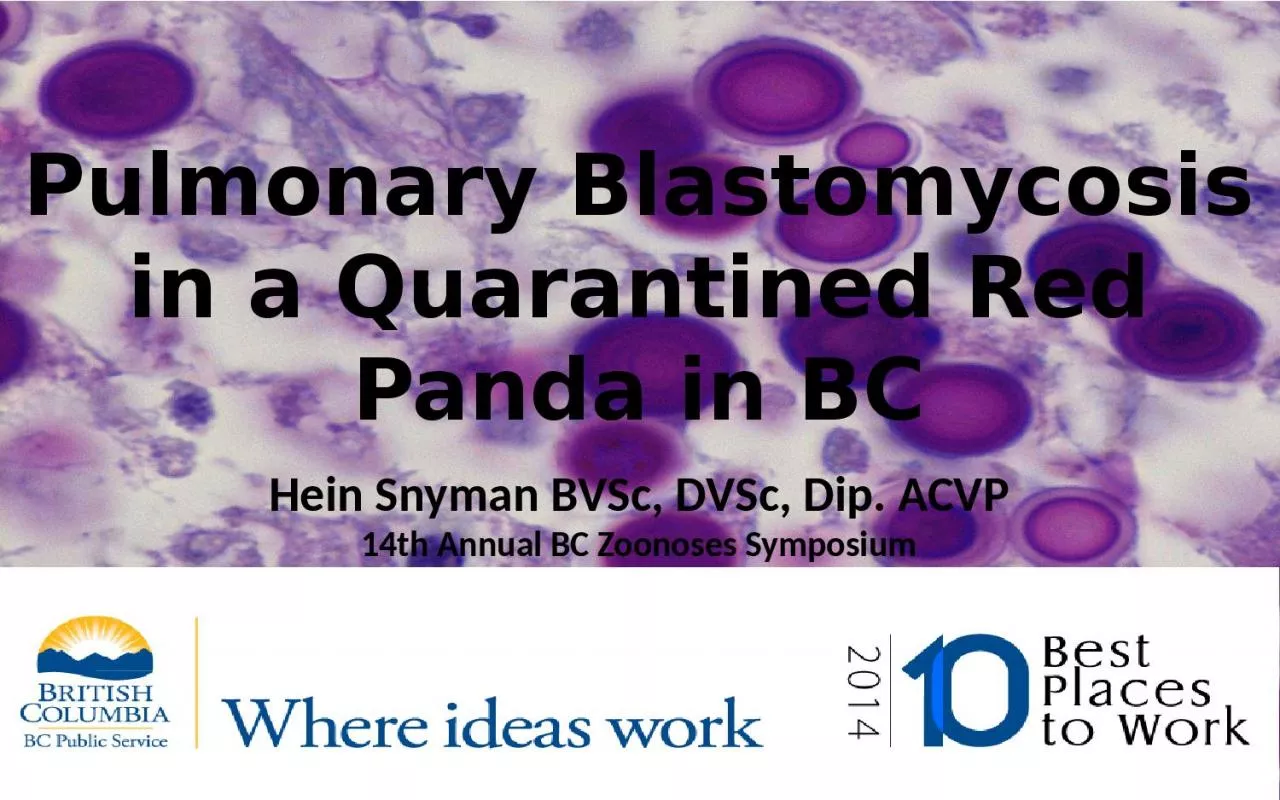

Panda in BC Hein Snyman BVSc DVSc Dip ACVP 14th Annual BC Zoonoses Symposium Introduction Pulmonary Blastomycosis Case Report Significance Risk Factors Remaining Questions Case History ID: 1040756
Download Presentation The PPT/PDF document "Pulmonary Blastomycosis in a Quarantined..." is the property of its rightful owner. Permission is granted to download and print the materials on this web site for personal, non-commercial use only, and to display it on your personal computer provided you do not modify the materials and that you retain all copyright notices contained in the materials. By downloading content from our website, you accept the terms of this agreement.
1. Pulmonary Blastomycosis in a Quarantined Red Panda in BCHein Snyman BVSc, DVSc, Dip. ACVP14th Annual BC Zoonoses Symposium
2. IntroductionPulmonary Blastomycosis Case ReportSignificanceRisk FactorsRemaining Questions
3. Case History~ 14 month old, intact male, Red Panda (Ailurus fulgens)Animal Health Centre (AHC) for necropsy Recently transferred along with conspecific panda to British Columbia from ManitobaPandas maintained in an isolated quarantine facility During quarantine, both pandas maintained a normal demeanour and appetiteThe panda presented with acute respiratory distress and succumbed prior to clinical interventionwall.alphacoders.com
4. Gross ObservationsPoor body condition (BCS 2/9).Disseminated multi-nodular pyogranulomatous pneumonia Multiple firm adhesions to the adjacent surfaces of the diaphragm and chest (stars) and throughout the mediastinum as and pericardial sac, diaphragm and thoracic wall (arrow heads)15 ml of a thick, tenacious, yellow-brown, mucopurulent exudate in pericardial cavity (arrow). DDx:ActinomycosisMycobacteriosisParasitic infections (e.g. Aelurostrongylus sp. Capillaria sp. etc.)Chronic aspiration pneumoniaNeoplasiaSystemic fungal diseases (e.g. Cryptococcosis, Histoplasmosis, and Blastomycosis)
5. HistopathologyAbundant yeast bodies (arrow heads) H&E
6. Nasal TurbinatesMultifocal mucosal ulcerationSimilar nodular inflammatory aggregates Abundant extra-cellular and phagocytized yeast bodies H&E
7. H&E
8. Yeast FeaturesPAS and GMS positive1-2 µm thick, double contour, clear and mucicarmine negative wallGrocott`s Methenamine Silver (GMS)
9. Yeast FeaturesPAS and GMS positive1-2 µm thick, double contour, clear and mucicarmine negative wallH&E
10. Periodic Acid-Schiff (PAS)
11. Additional TestingFrozen samples of the lung were submitted to the Public Health Microbiology & Reference Laboratory at the BCCDCUniversal ITS fungal gene PCR and subsequent sequencing confirmed the presence of Blastomyces dermatitidis.
12. Additional FindingsMarked bone marrow hyperplasiaRefractive sporesH&E; Refraction
13. ConclusionPulmonary BlastomycosisInfection occurring through inhalationExtensive involvement of the lung and associated fibrous organisation, marked bone marrow hyperplasia and accompanying poor body condition = Chronic infection
14. ConclusionChronicity of the infectionStrict quarantine proceduresOriginated from a highly endemic region (Winnipeg Manitoba)Highly unlikely that infection occurred in BCwww.danharperphotography.com
15. Immediate RiskMycelia and spores Risk for human infection and horizontal spread is minimaldog bitecat scratchaccidental inoculation during necropsy Direct transmission to the conspecific red panda unlikely Same original environmental source
16. Environmental Risk FactorsEndemic regions are well knownLittle detail regarding specific habitats or environmental determinantsExcept: Warm, moist soils Wooded areas - rich in organic debrisNear waterSpecific climatic changes/factorswww.parrysound.com
17. Environmental Risk FactorsEnvironmental isolation of organisms extremely difficult and reports limited Animal inoculationsIn vitro culture with selective and non-selective mediaMolecular DNAwww.mycology.adelaide.edu.au
18. Remaining QuestionsLikelihood & significance of shedding?Biotic and abiotic factors to allow survival, persistence and propagation in the environment?Different strains with better adaptation to certain environments and different pathogenicity?Proximity and likely frequency of travel to endemic areas?www.skydivemag.com
19. Dr. Melissa McLaws (Public Heath Veterinarian, BCCDC)Dr. Linda Hoang (Medical Microbiologist, BCCDC)Thank You
20. References1. Davies JL, Epp T, Burgess HJ. Prevalence and geographic distribution of canine and feline blastomycosis in the Canadian prairies. Can Vet J. 2013 Aug;54(8):753-60.2. Nicole J. Fernandez, Debra W. Henderson, Tim Spotswood, and Richard Christmas. Multi-systemic disease in a dog. Can Vet J. 2008 Jul; 49(7): 715–722. 3. Gray NA, Baddour LM. Cutaneous inoculation blastomycosis. Clin Infect Dis. 2002;34:E44–49.4. Brömel, C., & Sykes, J. E. (2005). Epidemiology, diagnosis, and treatment of blastomycosis in dogs and cats. Clinical Techniques in Small Animal Practice, 20(4), 233–9.5. Saccente M, Woods GL. Clinical and laboratory update on blastomycosis. Clin Microbiol Rev. 2010 Apr;23(2):367-81. doi: 10.1128/CMR.00056-09.6. Reed, K. D., Meece, J. K., Archer, J. R., & Peterson, A. T. (2008). Ecologic niche modeling of Blastomyces dermatitidis in Wisconsin. PloS One, 3(4).